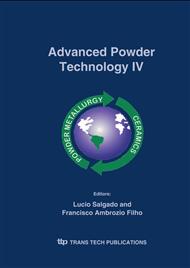p.546
p.552
p.558
p.564
p.569
p.575
p.581
p.587
p.594
Oxidation Behavior of Hot-Pressed Si3 N4 Ceramics Using CRE2 O3 -AlN and CRE2 O3 -Al2 O3 as Sintering Additives
Abstract:
In this work, an yttrium and rare-earth oxides mixture, CRE2O3, produced at DEMAR-FAENQUIL, was used as sintering additive for silicon nitride (Si3N4) ceramics. Samples were produced by uniaxial hot-pressing, using mixtures of CRE2O3- Al2O3 or CRE2O3-AlN as additives. Four kind of hot-pressed Si3N4 were used as oxidation samples: Si3N4+ 5vol% or 20vol.% of CRE2O3-Al2O3 (forming only β-Si3N4 as crystalline phase), Si3N4+ 5vol.%CRE2O3-AlN (α-SiAlON+β) and Si3N4+ 20vol.%CRE2O3-AlN (only α-SiAlON). The oxidation behavior was evaluated at 13500C, in air up to 160 hours. The oxidation rate of Si3N4 ceramics increased with increasing CRE2O3/Al2O3 content, and oxidation kinetics obeyed the usual parabolic law. Pure α-SiAlONs (Si3N4 +20 vol.% CRE2O3-AlN) were high oxidation resistant with weight gain, after 160 hours, of 0.1 mg.cm-2, while β-Si3N4+20vol.%CRE2O3- Al2O3 showed a weight gain of 1.4 mg.cm-2 after only 10 hours. The oxidation behavior of these ceramics was comparable with ceramics sintered with Y2O3. This result confirms the possibility of the fabrication of high oxidation resistance Si3N4 ceramics using the low cost sintering additive CRE2O3.
Info:
Periodical:
Pages:
569-574
Citation:
Online since:
November 2005
Keywords:
Price:
Сopyright:
© 2005 Trans Tech Publications Ltd. All Rights Reserved
Share:
Citation:


